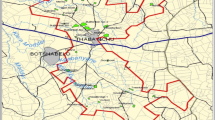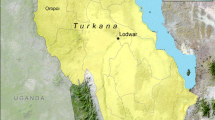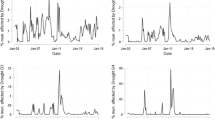Abstract
Drought is an important downside risk in Indian agriculture; and the spatial differences in its intensity and probability of occurrence are considerable. To develop strategies to manage the risk of drought, and to coordinate and implement these strategies, it is essential to understand the variation in drought risk across geographical or administrative levels. This paper, using a multilevel modeling approach, decomposes the variation in drought risk across states, regions, districts, villages and households, and finds it disproportionately distributed. About half the variation is attributed to between-individual (i.e., household) differences and the rest to between-population differences, mainly to states and villages. These findings suggest the potential for a critical role of states (policies) and local institutions (communities) in enhancing resilience of agriculture to droughts through the correct targeting of policies and support for the most appropriate geographic level.



Similar content being viewed by others
Notes
We calculate the Simpson index to know the extent of diversification. The index is bounded between 0 and 1. A value closer to 1 means a higher level of diversification.
The value of assets does not include the value of land used for agricultural purposes.
A simple random sample of individuals with no correlation of crop loss among individuals will result in 100% VPC at the individual (household) level.
References
Aditya KS, Khan MT, Kishore A (2018) Adoption of crop insurance and impact: insights from India. Agric Econ Res Rev 31(2):163–174
Agrawal A, Perrin N, Chhatre A, Benson CS, Kononen M (2012) Climate policy process, local institutions, and adaptation actions: mechanisms of translation and influence. WIREs Clim Chang 3:565–579
Akerlof GA (1997) Social distance and social decisions. Econometrica 65(5):1005–1028
Amare M, Jensen ND, Shiferaw B, Cisse JD (2018) Rainfall shocks and agricultural productivity: implication for rural household consumption. Agric Syst 166:79–89
Anselin L (2002) Under the hood: issues in the specification and interpretation of spatial regression models. Agric Econ 27(3):247–267
Aryal JP, Sapkota TB, Stirling CM, Jat ML, Jat HS, Rai M, Mittal S, Sutaliya JM (2016) Conservation agriculture-based wheat production better copes with extreme climate events than conventional tillage-based systems: a case of untimely excess rainfall in Haryana, India. Agric Ecosyst Environ 233:325–335
Barbieri AF, Pan WK (2012) People, land, and context: multilevel determinants of off-farm employment in the Ecuadorian Amazon. Popul Space Place 19(5):558–579
Birthal PS, Hazrana J (2019) Crop diversification and resilience of agriculture to climatic shocks: evidence from India. Agric Syst 173:345–354
Birthal PS, Negi DS, Khan MT, Agarwal S (2015) Is Indian agriculture becoming resilient to droughts? Evidence from rice production systems. Food Policy 56:1–12
Birthal PS, Negi DS, Hazrana J (2019) Trade-off between risk and returns in farmers’ choice of crops: evidence from India. Agric Econ Res Rev 32(1):11–23
Britton M (1990) Geographical variation in mortality since 1920 for selected causes. In: Britton M (ed) Mortality and geography: a review in the mid-1980's for England and Wales. HMSO, London
Campbell BM, Vermeulen SJ, Aggarwal PK, Corner-Dolloff C, Girvetz E, Loboguerrero AM, Ramirez-Villegas J, Rosenstock T, Sebastian L, Thornton P, Wollenberg E (2016) Reducing risks to food security from climate change. Glob Food Secur 11:34–43
Carey RK (2007) Modeling N2O emissions from agricultural soils using a multi-level linear regression. Duke University, Durham
Carter M, de Janvry A, Sadoulet E, Sarris A (2014). Index-based weather insurance for developing countries: a review of evidence and a set of propositions for up-scaling. Background document for the workshop “microfinance products for weather risk management in developing countries: state of the arts and perspectives”. Paris, June 25
Curtis SL, Diamond I, McDonald JW (1993) Birth interval and family effects on post neonatal mortality in Brazil. Demography 30(1):33–43
Das P, Bhuyan-Aranyak H (2013) Policy and institutions in adaptation to climate change – case study on flood mitigation infrastructure in India and Nepal. ICIMOD working paper 2013/4, International Centre for Integrated Mountain Development, Kathmandu, Nepal
Dercon S (1996) Risk, crop choice, and savings: evidence from Tanzania. Econ Dev Cult Chang 44(3):485–513
Di Falco S, Chavas JP (2008) Rainfall shocks, resilience and the dynamic effects of crop biodiversity on the productivity of the agroecosystems. Land Econ 84(1):83–96
Durlauf SN (1996) Statistical mechanics approaches to socioeconomic behavior. NBER technical working paper 0203, National Bureau of Economic Research, Inc
Easterling W, Aggarwal P, Batima P et al (2007) Food, fibre and forest products. In: Parry ML, Canziani OF, Palutikof JP, van der Linden PJ, Hanson CE (eds) Climate change 2007: impacts, adaptation and vulnerability. Cambridge University Press, Cambridge, pp 273–313
Fan Y, Massey R, Park SC (2018) Multi-crop production decisions and economic irrigation water use efficiency: the effects of water costs, pressure irrigation adoption, and climatic determinants. Water 10(11):1–26
GoI (2009) Manual for drought management. Ministry of Agriculture and Farmers’ Welfare, Government of India, New Delhi
GoI (2015) Situation assessment survey of agricultural households, 70th round. National Sample Survey Office, Ministry of Statistics and Programme Implementation, Government of India, New Delhi
Goldstein H (2003) Multilevel Statistical Models, 3rd edn. Edward Arnold, London and Wiley, New York
Goldstein H, Spiegelhalter DJ (1996) League tables and their limitations: statistical issues in comparisons of institutional performance. J R Stat Soc A159:505–513
Gray J, Jesson D, Goldstein H, Hedger K, Rasbash J (1995) A multilevel analysis of school improvement: changes in school performance over time. Sch Eff Sch Improv 6(2):97–114
Guo G (1993) Use of sibling data to estimate family mortality effects in Guatemala. Demography 30(1):15–32
Khanal AR, Mishra AK (2017) Enhancing food security: food crop portfolio choice in response to climatic risk in India. Global. Food Secur 12:22–30
Kumar V, Ladha JK (2011) Direct-seeding of rice: recent developments and future research needs. Adv Agron 111:297–413
Kurukulasuriya P, Kala N, Mendelsohn R (2011) Adaptation and climate change impacts: a structural Ricardian model of irrigation and farm income in Africa. Clim Chang Econ 2:149–174
Lamb R (2002) Weather risk, crop mix, and wealth in the semi-arid tropics. Department of Agricultural and Resource Economics, North Carolina State University, Raleigh
Macintyre S (1986) The patterning of health by social position in contemporary Britain: directions for sociological research. Soc Sci Med 23:393–415
Michler JD, Shivley G (2016) Agricultural production, weather variability, and technical change: 40 years of evidence from India. Paper presented in the annual meeting of the Agricultural and Applied Economics and Association at Boston, Massachusetts, July 31-August 2
Neumann K, Stehfest E, Verburg PH, Siebert S, Muller C (2011) Exploring global irrigation patters: a multilevel modeling approach. Agric Syst 104:703–713
Overmars KP, Verburg PH (2006) Multilevel modelling of land use from field to village level in the Philippines. Agric Syst 89:435–456
Palanisami K, Mohan K, Kakumanu KR, Raman S (2011) Spread and economics of micro-irrigation in India: evidence from nine states. Econ Polit Wkly 46(26/27):81–86
Pray C, Nagarajan L, Li L, Huang J, Hu R, Selvaraj KN, Napasintuwong O, Babu RC (2011) Potential impact of biotechnology on adaptation of agriculture to climate change: the case of drought tolerant rice breeding in Asia. Sustainability 3(10):1723–1741
Qian SS, Cuffney TF, Alameddine I, McMahon G, Reckhow KH (2010) On the application of multilevel modeling in environmental and ecological studies. Ecology 91(2):355–361
Rathore BMS, Sud R, Saxena V, Rathore LS, Rathore TS, Subrahmanyam VG, Roy MM (2014) Drought conditions and management strategies in India- country report. Presented at the regional workshop for Asia-Pacific on capacity development to support National Drought Management Policies Hanoi, UN water initiative, May 6–9
Raudenbush SW, Bryk AS (2002) Hierarchical linear models: applications and data analysis methods (2nd ed). Sage Publications, Thousand Oaks
Rogers DH, Lamm FR, (2012) Kansas irrigation trends. In: Proceedings of the 24th Annual Central Plains Irrigation Conference, Colby, Kansas, February 21–22, 2012 Available from CPIA, 760 N. Thompson, Colby, Kansas, USA
Roscigno VJ (1998) Race and reproduction of educational disadvantages. Soc Forces 76:1033–1060
Rosenzweig CA, Binswanger HP (1993) Wealth, weather risk and the composition and profitability of agricultural investments. Econ J 103(416):56–78
Salazar C, Ayalew H, Fisker P (2018) Weather shocks and spatial market efficiency: evidence from Mozambique. J Dev Stud:1–16. https://doi.org/10.1080/00220388.2018.1528352
Seo SN (2010) A micro econometric analysis of adapting portfolios to climate change: adoption of agricultural systems in Latin America. Appl Econ Perspect Policy 32(3):489–514
Seo SN, Mendelsohn R (2008) An analysis of crop choice: adapting to climate change in Latin American farms. Ecol Econ 67:109–116
Sharma PK, Bhushan L, Ladha JK, Naresh RK, Gupta RK, Balasubramanian BV, Bouman BAM (2002) Crop water relations in rice–wheat cropping under different tillage systems and water management practices in a marginally sodic, medium-textured soil. In: Bouman BAM, Hengsdijk H, Hardy B, Toung TP, Ladha JK (eds) Water-wise rice production. International Rice Research Institute, Manila
Singh NP, Anand B, Singh S, Khan A (2019) Mainstreaming climate adaptation in Indian rural development agenda: a micro-macro convergence. Clim Risk Manag 24:30–41
Subramanian S, Jones K, Duncan C (2003) Multilevel methods for public health research. In: Kawachi I, Berkman L (eds) Neighborhoods and health. Oxford Press, New York
Taraz V (2017) Adaptation to climate change: historical evidence from the Indian monsoon. Environ Dev Econ 22(5):517–545
Thompson A, Robbins P, Sohngen B, Arvai J, Koontz T (2006) Economy, politics, and institutions: from adaptation to adaptive management in climate change. Clim Chang 78(1):1–5
Vance C, Iovanna R (2006) Analyzing spatial hierarchies in remotely sensed data: insights from a multilevel model of tropical deforestation. Land Use Policy 23(3):226–236
Young KR, Lipton JK (2006) Adaptive governance and climate change in the tropical highlands of western South America. Clim Chang 78:63–102
Zampieri M, Ceglar A, Dentener F, Toreti A (2017) Wheat yield loss attributable to heat-waves, drought and water excess at the global, national and subnational scales. Environ Res Lett 12:064008
Zhang LE, Liao C, Zhang H, Hua X (2018) Multilevel modeling of rural livelihood strategies from peasant to village level in Henan Province, China. Sustainability 10(2967):1–13
Author information
Authors and Affiliations
Corresponding author
Additional information
Publisher’s note
Springer Nature remains neutral with regard to jurisdictional claims in published maps and institutional affiliations.
Appendix
Appendix
Rights and permissions
About this article
Cite this article
Birthal, P.S., Hazrana, J. & Negi, D.S. A multilevel analysis of drought risk in Indian agriculture: implications for managing risk at different geographical levels. Climatic Change 157, 499–513 (2019). https://doi.org/10.1007/s10584-019-02573-9
Received:
Accepted:
Published:
Issue Date:
DOI: https://doi.org/10.1007/s10584-019-02573-9




